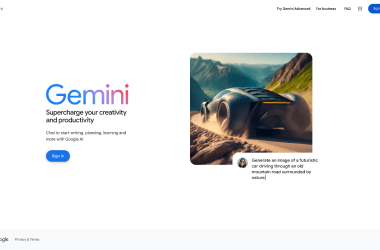Updated: Sep 11, 2024 By: Marios

There’s a reason Apple, Google, and Microsoft are now all aboard the AI train. The future of tech is looking more exciting than ever, with many industries set to revolutionize as models become more advanced and refined, and utility is increased. We can only hope it leads to more free hours, better creativity, and less grunt work.
Yet it’s also true that using AI is not a zero-sum game. You can still celebrate everything human about your brand while still leveraging these tools. Perhaps for one brand, it’ll be a 10% change, for others they prefer to keep it 50% human, 50% AI in their daily workflow. These divisions will only shift and blur more and more as we move into the future.
For this reason, as we move forward it’s wise to consider how to sustain your human factor, even after making use of AI. This way you can still enjoy the technology and not join those decrying it at every moment, but still understand that the fact you, a human person, are running your business grants it a special, irreplaceable quality.
With that in mind, let’s consider how to meet that balance:
The Power Of Stories
We’ve all seen content that feels robotic, where every post is optimized to the perfect degree and generated, but if it’s not tweaked or made relevant, it can seem detached. Sure, the writing may be technically acceptable, but it could lack the unique insight you, as a business owner who opened their enterprise for a reason (likely a personal one), can only discuss.
The trick is to use AI to enhance your storytelling, not replace it. AI can help analyze what works and streamline your content distribution, but it’s best left at that until further innovations take place. For example, if you’re a family business you may wish to write your story.
Could any AI do that better than you? You could use AI to provide a structure to get you started and to hit on points for naturally fitting in the best keywords, but you don’t have to filter your organic story by using such tools to do so.
After all, stories are what make us human. That, strangely enough, also means you don’t have to be perfect in how you tell them, but engaging and relatable. So ask yourself – what’s the bigger picture here? What journey are you taking your audience on? AI can help you piece it all together, but nothing can replace your perspective.
Running & Covering In-Person Events
As much as we’ve become used to virtual meetings, there’s something heartfelt and wonderful about face-to-face engagement. That doesn’t mean tech won’t help you run a business event or put your brand out there, for example, you could think about capturing an event with the help of a drone like the DJI Neo to get better flight shows, and you’ll still be in-person and ready to enjoy your guests and present to them.
You can then use AI to edit the footage, matching it up with a B-roll you may have taken, and automatically trimming out the dull parts.
Then you’ll see that covering an event you’ve run isn’t just good for the itinerary or structure of the day (though this is important), but also the energy, the conversations, and the sense of showmanship you provide to help you spread your brand message. If you’re looking to sustain your human factor, you could absolutely do worse than remaining present, willing, and affable in personal events.
Don’t Let AI Overtake Your Brand’s Voice
AI can be fantastic for helping you articulate yourself in new and more effective ways, but remember that good communication isn’t always about just effective and flowery speaking. Any new creative writing graduate can often pen something that sounds lovely, but if the message is obscured and not for artistic purposes, that’s a problem.
As such, if you do decide to integrate AI into your marketing process, remember that emotion still drives connection. Putting ti simply, people don’t remember posts for their efficiency; they remember them for how they made them feel. This is especially true in marketing when you’re trying to convince someone that the lack they have noticed could be solved by your product or service.
As a thought experiment – think of your favorite campaign or brand, and is if it was the precision of the message that stood out, or the heart behind it? This doesn’t mean you need to shy away from AI’s help or that AI tools are incapable of providing relatable copy, but it does mean that the core should always come from you and your perspective, as well as personal research conducted on your ideal target market. If you know who to speak to, you know how to speak to them.
Customer Interaction Can Be Automated, But Warmth Will Always Have A Place
Customer support is one of those departments where AI can be a massive, almost unbelievable help, but also where the human touch matters most. How do you strike that balance? Well, automated responses, chatbots, and some self-service options are convenient, no doubt, as they allow you to handle more queries in less time, and customers get quicker answers. They can also help you direct individuals to FAQs to save one-on-one time.
A good balance here could involve using AI to handle the basics, like the routine questions, and the FAQs as mentioned above, but then making sure a real person is always just a click away. Perhaps there’s a way to contact an agent if the AI provides no use with its recommendations. That way, customers never feel like you’re just assigning all the work to the AI, but are given several steps to have benefited from it before moving into the traditional approach.
Implementing AI-driven solutions for routine customer interactions allows businesses to efficiently manage inquiries. However, integrating knowledge base software is key when more complicated issues arise. These systems equip human agents with vital information, ensuring they provide prompt and accurate support without missing the human touch that customers value. Ensuring a seamless transition from AI to human interaction requires not only sophisticated AI tools but an equally robust knowledge management system.
Use Bespoke, Human-Designed Branding Art
AI art can be good for a video thumbnail or a blog post for example, but for branded materials, it’s best to retain the same kind of originality you can only get from human-led creative experience.
When you hire someone to draw or create, that energy comes through in ways AI can’t replicate at the moment, and this adds depth. They also know how to create perfect social media banners, how color can influence mood, and how to properly depict the tone you’re setting and the services you’re offering.
Of course, AI can certainly lend a hand with mockups or quick iterations, but when you’re looking to build a final piece or looking for a final review, having an artist’s touch can be invaluable. Again, that’s no slight on AI, it’s just that sometimes you need to understand what such tools are good for, and not leave everything, especially not your identity, up to the computer.
Art that’s designed with a personal touch feels more alive and helps keep your brand grounded in something real. People will notice that even if they’re not sure why they notice it.
Really Understand Prompts, Don’t Just Use Simple Returns
The truth is that many people use AI simply and give it simple instructions designed for convenience. But these tools are often much better when you give them refined content or instructions that can limit the parameters of what you get back. This helps with achieving quality and consistency too, no matter if you’re hoping to write an email or just put notes together for a briefing.
In other words, it’s healthy to think of AI prompts as a tool to get good at like anything else. There’s a tendency to take the first result AI tools offer, but when you dig deeper, you often find there’s more room for nuance, and perhaps forty other businesses are using the exact same prompt you are to try and stand out.
That leads to a weird situation where everyone is talking eloquently, but they’re all saying the same thing. That’s a problem many industries are going to have to work through in the next decades.
For instance, instead of just asking AI for “the best blog post ideas,” you could give it more context, like the tone you’re going for or an audience pain point you’re targeting for the best engagement. You can even use it for research and then fact-check that later to improve your article posting. Again, you don’t have to be binary with AI, just little pointers in the right direction can lead you to the best results.
Have An AI Review & Acceptance Process In Place
Lastly, you don’t just have to take what AI gives you no questions asked. If you put in a process to review content and test systems AI helps you design can allow you to avoid putting out poor outcomes that other businesses sometimes fall into the trap of.
This might not help but delay your workflow to begin with, but the time and money you save avoiding mistakes or reputational damage is priceless.
With this advice, you’ll be certain to sustain the human factor of your business, even after using the wonder of AI.



